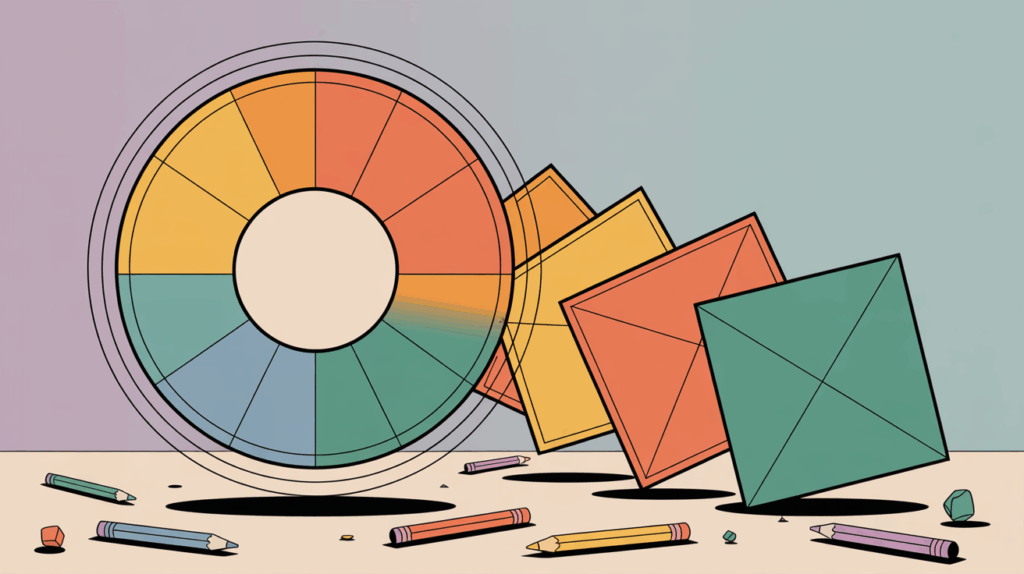Zero. Or maybe infinite? That question often confuses. Most people get stuck when trying to count a circle’s sides. The issue comes from how we define “sides” in geometry.
When we look at squares or triangles, the answer seems clear – count the straight lines. But circles? They don’t play by those rules, making many feel lost when discussing this basic shape.
Circles are both the simplest and most complex shapes in geometry. They follow different rules than polygons, yet they’re found all around us – from the sun to coins in our pockets.
Let’s examine what makes circles special and finally settle the debate about how many sides a circle has.
What is a Side in Geometry? Understanding the Basics
In geometry, we need to know what a “side” actually means before we can talk about circles. A side is simply a straight line segment that forms part of a shape.
When we look at common shapes, sides become obvious:
- A triangle has 3 sides (straight lines connected at angles)
- A square has 4 sides (equal straight lines at right angles)
- A pentagon has 5 sides (straight lines forming a closed shape)
Traditional sides must be straight. This rule helps us classify shapes into families. Polygons, for example, are shapes with straight sides only.
But what about curves? This is where things get tricky. Curved lines don’t fit the standard definition of sides. A circle consists of a single curved line where all points are the same distance from the center.
Think of it this way: if you zoom in close enough on a circle, the curve starts to look more like many tiny straight lines connected together.
How Many Sides Does a Circle Have?

This question has more than one answer, depending on how we think about sides. Let’s look at the main ideas:
Zero Sides Theory:
- A circle has no straight lines.
- By strict definition, a side must be straight.
- Since circles are curved all the way around, they have zero sides.
- Mathematicians often use this answer in formal settings.
Infinite Sides Theory:
- Think of a circle as having many, many tiny straight lines.
- As these lines get smaller and more numerous, they form a smooth curve.
- If we keep adding more lines and making them smaller, we approach infinity.
- This view helps us understand calculus and advanced math.
Both answers are correct in their own way! If we stick to the basic rule that sides must be straight, then circles have zero sides. But if we look at how circles work in higher math, they can be seen as shapes with infinite tiny sides.
Polygons Approaching a Circle (Limits Concept)
While a circle has no sides, you can get very close to its shape using polygons with many sides. This idea is rooted in the mathematical concept of limits.
Start with a basic shape like a hexagon (6 sides). If you increase the number of sides, say to 20, 100, or 1,000, the polygon starts to look more and more like a circle. In fact, as the number of sides approaches infinity, the shape approaches the form of a circle.
This doesn’t mean the circle has infinite sides. It means that:
A circle is the limit of an n-sided regular polygon as n approaches infinity.
So, while polygons can approximate a circle very closely, a true circle remains fundamentally different: it’s smooth and curved, not made of sides at all.
Why a Circle Doesn’t Have Traditional Sides?

In geometry, a side is a straight line between two corners (vertices) of a shape. Polygons like triangles and squares have sides because they’re made of straight edges.
A circle, however, is a smooth, continuous curve with no straight lines and no corners. Since it doesn’t have line segments or vertices, it doesn’t meet the definition of having “sides.”
Simply put: A circle has 0 traditional sides because it’s not made of straight edges, just one continuous curve.
Real-World Examples: Do Circular Objects Have Sides?
The question about how many sides a circle has becomes even more interesting when we look at objects around us. Let’s see how this plays out in the real world.
- Coins: Look smooth from a distance, but have tiny ridges around the edge that work like countless mini-sides
- Wheels: Roll smoothly because they lack flat sides, though bike tires have treads that create small straight segments
- Pizza: Cut into triangular slices with straight sides, yet the outer crust forms one curved edge
- Clock faces: Perfect examples of how we place straight items (hands) on a round surface
- Wedding rings: Show how circles symbolize an endless connection with no beginning or endpoint
- CDs and DVDs: Appear to have perfect circular edges, but contain microscopic pits that work as data points
- Dinner plates : Need rounded edges for safety and function, imagine eating from a plate with sharp corners!
- Buttons: Often circular for easy handling and to slide through holes in fabric
- Camera lenses : Must be round to focus light properly, the curved shape helps create clear images.
This shows how the “no sides” feature of circles makes them ideal for many uses. When we need something to roll, spin, or avoid sharp corners, circular shapes work best.
Their special property, lacking traditional sides, gives them unique advantages in our daily lives.
Conclusion
So, what’s the final count on how many sides does a circle have? Both zero and infinity make sense, depending on how you think about it.
The beauty of this question lies in how it shows math isn’t always about one right answer. Sometimes, the way we look at a problem matters just as much as the answer itself.
Circles stand apart from other shapes with their perfect, smooth form. This unique quality makes them essential in our world – from wheels to wedding rings.
Next time you see a circular object, take a moment to think about its special nature. And if someone asks you how many sides does a circle have, you can now explain both viewpoints with confidence!
















